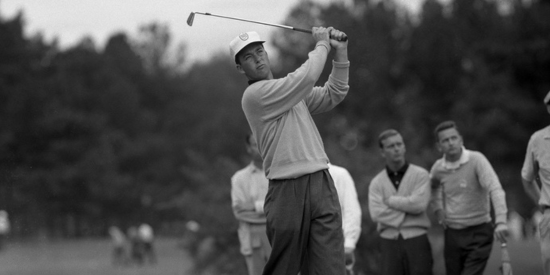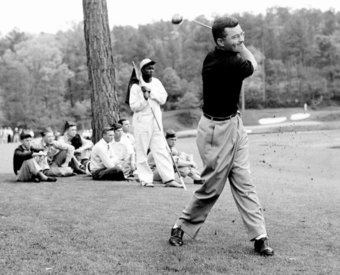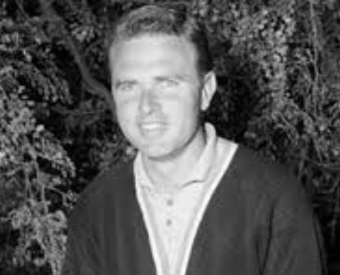
Ken Venturi at the 1956 Masters
While no amateur has ever donned the Green Jacket, several have turned in performances that will forever be a part of Masters lore.
Frank Stranahan made a bold dash in the final round to tie Byron Nelson for second behind Jimmy Demaret, while Billy Joe Patton narrowly missed out on joining Ben Hogan and San Snead in a playoff in 1954. There was the painful final round demise of Ken Venturi in 1956, when the San Francisco native blew a four-shot lead in the final round and ultimately finished second.
Charlie Coe, who won low amateur honors at Augusta in four consecutive decades, was one of three amateurs to finish in the top-15 in 1961 while Ryan Moore, then a 21-year-old senior at UNLV, strung together rounds of 71-71-75-70 in 2005 to finish in a tie for 13th.
Here's a closer look at some of the top performances by amateurs in The Masters:
• • • • •
1947: Stranahan closes strong to finish second
Frank Stranahan began the final round of the 1947 Masters tie for seventh with Henry Picard, five strokes off the lead of 54-hole leader Jimmy Demaret. Stranahan would shoot a final round 68 - the lowest of the day - to tie his mentor Byron Nelson for second place at 5-under, just two behind Demaret.
Stranahan remained an amateur for most of his career and built an enviable resume. He played three winning Walker Cup teams in 1947, 1949, and 1951, won the British Amateur twice (1948, '50), the Western Amateur four times (1946, '49, '51, '52) and the North and South Amateur on three occasions (1946, '49, '52). He was also a four-time winner of the World Amateur Championship (1950, '51, '52, '53, '54) and twice won the Canadian Amateur (1947, '48).
• • • • •
Related: The Masters: Meet the seven amateurs who will be competing for the Silver Cup
• • • • •
1954: Billy Joe Patton finishes a stroke out of a playoff with Hogan and Snead
Billy Joe Patton, a junior executive at a lumber company in Morganton, NC, nearly won the 1954 Masters but finished one stroke out of a playoff with eventual champion Sam Snead and Ben Hogan by a single stroke after his second shot on the par-5 13th hole came up short and splashed into Rae’s Creek. He went on to play in the next dozen Masters tournaments.
 Billy Joe Patton
Billy Joe Patton “You know what, I was better off not winning it,” Patton told the Greensboro News & Record in 2004, seven years before his death at age 88. “I’ve lived a very happy life. If I hadn’t lived such a happy life, I might feel differently.”
One of the most accomplished amateurs of all-time, Patton played on five U.S. Walker Cup Teams (1955, 1957, 1959, 1963 and 1965) and he captained the USA squad in the 1969 Match. He also represented the USA on two World Amateur Teams (1958 and 1962). He won three North and South Amateurs and two Southern Amateurs on Pinehurst No. 2 and was a two-time champion of the Carolinas Open.
In 1982, he received the Bob Jones Award for his distinguished sportsmanship in golf. He passed away on Jan. 1, 2011 at the age of 88.
1956: Venturi's bitter final round disappointment
Ken Venturi started the final round of the 1956 Masters with a four-stroke lead, but then shot 80 to lose to Jackie Burke by one. Venturi carded a first-round 66 to become the first amateur ever to hold the undisputed lead in the Masters after the first round. A second-round 69 left him a 9-under 135, equalling the 36-hole record shared by Henry Picard (1935) and Byron Nelson (1942) and gave him a comfortable four-stroke lead over his closest pursuer, Cary Middlecoff. He managed a third-round 75 in fierce winds on Saturday to maintain a four-shot lead over Middlecoff heading into the final round. It was Venturi's tournament to lose, and unfortunately, he did just that, shooting an 80 in the final round. Jackie Burke Jr., who began the day eight back, shot a 71 to deny Venturi Masters glory by a single stroke.
"I hit 15 greens but three-putted six times," said Venturi. "The mistake I made was consciously trying to two-putt every green and just coast home."
1957: Another Silver Cup for Harvie Ward
 Harvie Ward
Harvie Ward One of the greatest amateur golfers of the 1950s, Ward finished fourth in the 1957 Masters, where he was one off the lead after three rounds. He also tied for eighth in the 1955 Masters, and tied for 14th in the 1953 Masters and was low amateur in all three of those Masters. Ward won both the U.S. and British Amateur championships and captured the NCAA championship in 1949. In 1948, he beat Arnold Palmer, 5 and 4, in the semifinals of the 1948 North and South Amateur and went on to defeat Frank Stranahan for the championship. Ward also was one of the four golfers who played what has become one of the most-famous matches in golf history, teaming with fellow amateur Ken Venturi against Ben Hogan and Byron Nelson at Cypress Point in 1956.
1961: Three amateurs finish in the top-15
While the 1961 Masters is more noted for Arnold Palmer making a double bogey on the final hole to lose the Masters to Gary Player, it also featured the greatest showing by amateurs in the history of the tournament. Long-hitting Charlie Coe, a native of Ardmore, Okla., needed a birdie on the final two holes to force a playoff with Player, but ultimately finished tied for second with Palmer, one back at 7-under-281. Jack Nicklaus, playing in his last Masters as an amateur, tied for seventh, six shots behind Coe. Robert Gardner, tied for 11th, one shot behind Nicklaus.
Coe won low amateur honors at Augusta in four consecutive decades: 1940s, 1950s, 1960s and 1970s. He also holds the amateur records for best finish (2nd in 1961), lowest third-round score (67 in 1959), and lowest 72-hole score (281 in 1961).
1998: Matt Kuchar's breakout performance
Matt Kuchar, then a 19-year-old sophomore at Georgia Tech, was the low amateur at even-par 288 and tied for 21st place. The reigning U.S. Amateur champion was paired with defending champion Tiger Woods for the first two rounds and more than held his own, opening with an even-par 72, despite making a double-bogey on 15 and bogey on 16. After a second round 76, Kuchar bounced back nicely with rounds of 68 and 72 to earn the Silver Cup. His even par score of 288 was the best score by an amateur since Rick Fehr in 1984.
2005: U.S. Amateur champion Ryan Moore finishes tied for 13th
Ryan Moore's 2004 season was one of the greatest years ever by an amateur golfer, winning the U.S. Amateur, the U.S. Public Links, the Western Amateur and the NCAA men's individual championships. It was arguably the best season by an amateur since Jones won the Grand Slam in 1930. Moore didn't lack confidence when he arrived on the grounds of Augusta National, proclaiming that he was there to challenge for the green jacket. He finished tied for 13th at 1-under 287, which was the best score by an amateur since Lindy Miller finished 2-under in 1978.
2023: Sam Bennett posting 8-under to stand in second place after 36-holes
It was the first time since Billy Joe Patton's remarkable performance in the 1950s that an amateur has held that position. While Bennett came in T16th in the end, he captivated viewers' hearts like Megha Ganne did in her low amateur performance in the 2021 U.S. Women's Open at Olympic Club in San Francisco.